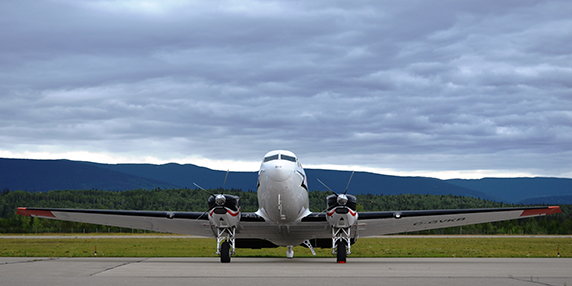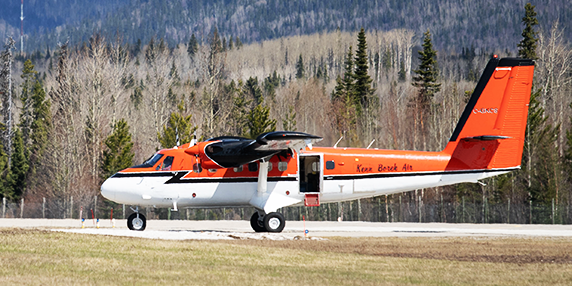Wildfire aviation
Helicopters and airtankers are a vital part of wildfire response in British Columbia, but they can’t contain wildfires on their own. The main purpose of aircraft is to support the work of ground crews.
The BC Wildfire Service has a fleet of around 40 aircraft with access to many more if needed. Aircraft are deployed based on needs of crews in the field. They perform a variety of functions like:
- Water and retardant delivery
- Crew and personnel transportation
- Gear delivery
- Logistics support
- Fire patrols
- Infrared scanning
Using aircraft is important because they help crews on the ground:
- Protect critical values
- Slow wildfire spread
- Support control lines
- Reduce heat
Rotary-wing aircraft (helicopters)
Rotary-wing aircraft, usually called "helicopters," are an essential tool for fighting wildfire.
The size and specifications of a helicopter determine the type of tasks it may be assigned. In general, larger helicopters can carry more weight, but cost more to operate. The BC Wildfire Service works closely with aircraft suppliers to use helicopters as effectively and efficiently as possible.
Helicopters may be used to:
- Transport firefighting crews
- Use buckets or belly tanks to drop water on a fire
- Transport gear and equipment
- Conduct infrared scanning
Watch videos about different helicopters used by the BC Wildfire Service: medium-lift helicopters and light utility helicopters.
The BC Wildfire Service also maintains exclusive access to a specialized fleet of helicopters designed to work with Rapattack crews. These helicopters are equipped with rappel and hoist equipment.
Airtankers
The BC Wildfire Service uses specialized fixed-wing aircraft called "airtankers" to support wildfire crews on the ground. There are two types of airtankers used in B.C.
Land-based airtankers
These airtankers are equipped with tanks that are specially designed to contain and drop fire retardant. They are capable of hitting multiple targets in one flight. Examples of these aircraft include the De Havilland Dash 8 Q400, Avro RJ-85 and Lockheed L-188 Electra.
Water-skimmers
Water-skimmers get their name from their ability to land on water and fill their tanks while moving. They are smaller in comparison to land-based airtankers and deliver water to support active firefighting operations. An example of this aircraft is the Air Tractor AT-802F Fire Boss.
Birddogs
All airtankers work in groups that are led by a "birddog" plane. Air attack officers, highly trained and experienced firefighters, sit beside the pilot in the birddog and coordinate the other aircraft on the mission. These aircraft fly above the others in order for the air attack officer to observe them. An example aircraft is the Turbo Commander TC-690A.
Other fixed-wing aircraft
The BC Wildfire Service also uses other fixed-wing aircraft to transport crews, conduct fire patrols and provide logistics support. Below are two examples used as jumpships for parattack crews.
Turbine DC-3
 Holds 13 smokejumpers and 2 command spotters, as well as all their gear.
Holds 13 smokejumpers and 2 command spotters, as well as all their gear.
Twin Otter DHC-6
 Short takeoff and landing aircraft that can transport seven smokejumpers as well as one command spotter.
Short takeoff and landing aircraft that can transport seven smokejumpers as well as one command spotter.
Frequently asked questions
How does the BC Wildfire Service decide how aircraft are used during the wildfire season?
BC Wildfire Service staff work continually to ensure that the most appropriate aircraft resources are available to respond to wildfires. This includes having aircraft stationed strategically around the province. The type of aircraft assigned to wildfires is based on need and availability. The number of aircraft being used from day to day and from week to week can fluctuate significantly, depending on the current wildfire situation.
At full operational readiness, the BC Wildfire Service operates a fleet of 19 airtankers and eight bird dog aircraft (in addition to its contracted helicopter fleet), with access to contract more if needed.
Can the BC Wildfire Service bring in additional firefighting aircraft if necessary?
The Province can bring in additional contracted aircraft as needed. Depending on the level of wildfire activity in the province, the government may request assistance from other jurisdictions through the Mutual Aid Resources Sharing Agreement, which allows for the movement and sharing of firefighting resources (including aircraft) between B.C. and other provinces and territories.
What is the current status of the Martin Mars airtanker?
The Martin Mars has been retired. It was last used to fight a wildfire in B.C. in 2015.
The Martin Mars was an iconic aircraft and part of this province’s proud firefighting history. Mars aircraft were originally built during World War II and then retrofitted as water bombers in 1959.
Does the BC Wildfire Service use heavy air tankers?
Yes, the Province's long-term contracted fleet includes several "heavy" type airtankers including 4 Electra L-188s and 2 RJ-85 580s.
Aircraft are frequently used to drop fire retardant and foam on or near a wildfire. Fire retardants, foam and water can help suppress a fire by cooling it down and smothering it. Learn more about what these materials are made from and how they work.
The BC Wildfire Service has provincial contracts for five rotary wing aircraft. The remaining aviation resources are solicited in early spring through BC Bid.

